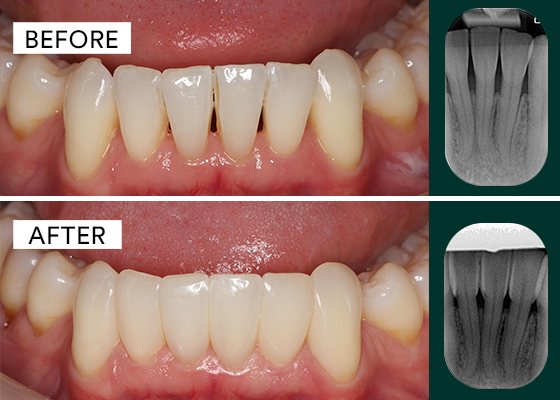Clinical Case: Composites made easy
Using 3M™ Filtek™ Easy Match Universal Restorative.


Innovative zirconia materials have a high esthetic potential. The authors of this report show how to leverage it – with the right refinement techniques.
For a long time, monolithic restorations made of zirconia were clearly indicated for the posterior region only. The materials available were simply not sufficiently translucent to be used in the anterior area without a porcelain layer. This is different today: innovative materials with a higher translucency, gradient shading technology and – in the case of 3M™ Lava™ Esthetic Fluorescent Full-Contour Zirconia – built-in fluorescence will produce highly esthetic results in specific situations.

Initial situation with insufficient PFM crowns on the maxillary central incisors.

Heavily discolored remaining tooth structure. The teeth are also in need of an endodontic retreatment.

Central incisors after cementation of fiber posts (3M™ RelyX™ Fiber Post 3D Glass Fiber Posts) with 3M™ RelyX™ Unicem 2 Automix Self-Adhesive Resin Cement, core build-up with 3M™ Filtek™ Bulk Fill Flowable Restorative and preparation.

Splinted crowns made of 3M™ Lava™ Esthetic Fluorescent Full-Contour Zirconia. Milling surface imperfections were removed with dedicated instruments to improve the morphology and texture features before sintering.

Surface treatment after sintering with a fine rubber to reduce the margin line offset and finish the surface texture.

Following sandblasting of the surface with alumina (50 µm grain size at 1 to 1.5 bar pressure), low-temperature stains are applied to increase the chroma and value effects in the enamel.

Creation of a perfectly smooth surface with a polishing brush and diamond polishing paste.

Finished restoration on the master cast.

Try-in of the splinted crowns. Prior to final cementation, the prepared stumps need to be cleaned thoroughly with pumice slurry, which is then removed by rinsing with water spray.

Application of self-adhesive cement (3M™ RelyX™ Unicem 2 Automix Self-Adhesive Resin Cement) into the cleaned crowns. PTFE tape is wrapped around the middle for simplified cleaning of the interproximal area after placement.

Excess removal subsequent to crown placement and brief light-curing of the cement (1 second).

Careful cleaning of the interproximal area with the PTFE tape.

Image of the final restoration taken with a polarizing filter to verify a good optical integration of the material.

Situation immediately after crown placement.

Treatment result at a recall after four months.

X-rays before and after the treatment.

Using 3M™ Filtek™ Easy Match Universal Restorative.

Using 3M™ Scotchbond™ Universal Plus Adhesive, 3M™ Filtek™ Supreme Flowable, 3M™ Filtek™ Supreme XTE, and 3M™ Sof-Lex™ coarse and medium…

Using 3M™ Filtek™ Easy Match Universal Restorative, and 3M™ Scotchbond™ Universal Plus Adhesive.